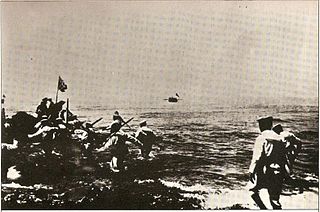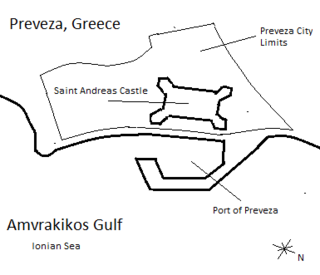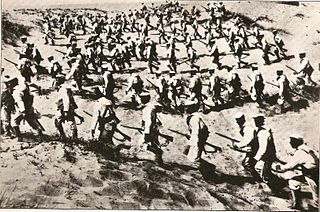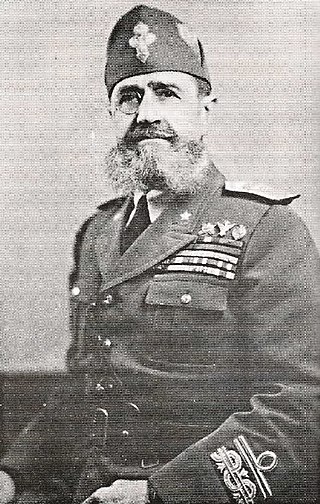Related Research Articles

The Italo-Turkish or Turco-Italian War was fought between the Kingdom of Italy and the Ottoman Empire from 29 September 1911, to 18 October 1912. As a result of this conflict, Italy captured the Ottoman Tripolitania Vilayet, of which the main sub-provinces were Fezzan, Cyrenaica, and Tripoli itself. These territories became the colonies of Italian Tripolitania and Cyrenaica, which would later merge into Italian Libya.

Italian war crimes have mainly been associated with Fascist Italy in the Pacification of Libya, the Second Italo-Ethiopian War, the Spanish Civil War, and World War II.

The Italian invasion of Libya occurred in 1911, when Italian troops invaded the Turkish province of Libya and started the Italo-Turkish War. As result, Italian Tripolitania and Italian Cyrenaica were established, later unified in the colony of Italian Libya.

The Italian colonizationof Libya began in 1911 and it lasted until 1943. The country, which was previously an Ottoman possession, was occupied by Italy in 1911 after the Italo-Turkish War, which resulted in the establishment of two colonies: Italian Tripolitania and Italian Cyrenaica. In 1934, the two colonies were merged into one colony which was named the colony of Italian Libya. In 1937, this colony was divided into four provinces, and in 1939, the coastal provinces became a part of metropolitan Italy. The colonization lasted until Libya's occupation by Allied forces in 1943, but it was not until the 1947 Paris Peace Treaty that Italy officially renounced all of its claims to Libya's territory.

Libya was a colony of Fascist Italy located in North Africa, in what is now modern Libya, between 1934 and 1943. It was formed from the unification of the colonies of Cyrenaica and Tripolitania, which had been Italian possessions since 1911.

Italy-Turkey relations are the relations between Italy and Turkey. Both countries are members of NATO and the Union for the Mediterranean and have active diplomatic relations. Relations between Turkey and Italy date back centuries in the form of various predecessor states.

Conflicts took place in North Africa during World War I (1914–1918) between the Central Powers and the Entente and its allies. The Senussi of Libya sided with the Ottoman Empire and the German Empire against the British Empire and the Kingdom of Italy. On 14 November 1914, the Ottoman Sultan proclaimed a jihad and sought to create a diversion to draw British troops from the Sinai and Palestine Campaign. Italy wished to preserve its gains from the Italo-Turkish War. The Senussi Campaign took place in North Africa from 23 November 1915 to February 1917.

The Battle of Preveza was the first naval engagement fought during the Italo-Turkish War, which took place in the Ionian Sea on 29–30 September 1911. The action took part in two separate engagements, the first off Preveza, and the second at Gomenítza the following day. Five Italian destroyers encountered a pair of Ottoman torpedo boats off the port of Preveza on 29 September and forced one aground; the second fled into the safety of Preveza. The next day, the Italian destroyers raided Gomenítza, where another two torpedo boats and an armed yacht were at anchor. The Italians sank both torpedo boats and seized the yacht as a prize.

The Second Italo-Senussi War, also referred to as the Pacification of Libya, was a conflict that occurred during the Italian colonization of Libya between Italian military forces and indigenous rebels associated with the Senussi Order. The war lasted from 1923 until 1932, when the principal Senussi leader, Omar al-Mukhtar, was captured and executed. The Libyan genocide took place during and after the conflict.

The Battles of Zanzur or Battles of Janzur, were a series of battles that took place in 1911–1912 at Zanzur oasis, near Tripoli during the Italo-Turkish War. During the battles, the Italians unsuccessfully attacked the Turkish-Arab stronghold located approximately twelve miles from the Italian lines at Tripoli until finally achieving a victory on 20 September 1912.

The battle and massacre at Shar al-Shatt occurred on 23 October 1911 in the village of Shar al-Shatt on the outskirts of Tripoli, Libya during the Italo-Turkish War. 482 Italian officers and men were killed in Shar al -Shatt, of which 290 in the following massacre of soldiers who had surrendered. The incident became known as the "Massacre of Italians at Sciara Sciat."
Events from the year 1911 in Italy.
Events from the year 1912 in Italy.

The Battle of Benghazi occurred during the Italo-Turkish War when the Kingdom of Italy attacked and took possession of the major cities of the Ottoman Empire's North African Tripolitania province, now Libya. Benghazi was one of the five strategic cities captured and held by the Italians during the entire length of the war.

The 11th Bersaglieri Regiment is an active unit of the Italian Army based in Orcenico Superiore in the Friuli Venezia Giulia region. The regiment is part of the army's infantry corps' Bersaglieri speciality and operationally assigned to the 132nd Armored Brigade "Ariete".

The Battle of Ain Zara was fought in December 1911 during the Italo-Turkish War between the Kingdom of Italy and Ottoman Empire forces for the control of the oasis of Ain Zara, near Tripoli in modern Libya, where the Ottomans had established a fortified base.
The Battle of Misrata was fought between Italian and Turkish forces on 9 July 1912 during the Italo-Turkish War. The battle was fought for control of the Tripolitanian town of Misrata, a major supply base for Ottoman forces.

The Battle of Tripoli was fought in October 1911, during the initial stages of the Italo-Turkish War, and saw the capture of Tripoli, capital city of Tripolitania, by Italian landing forces. It marked the beginning of the land campaign in Libya of the Italo-Turkish War as well as the beginning of the Italian colonization of Libya.

Sebastiano Gallina was an Italian general who served in the Italo-Turkish War, World War I, the Pacification of Libya, the Second Italo-Ethiopian War and World War II. Having spent most of his career in Italy's African colonies, he was considered among the most experienced Italian generals in colonial warfare.

Felice De Chaurand de Saint Eustache (1857-1944) was an Italian general and spy who was a major contributor of the early Servizio Informazioni Militare as well as the commander of the Italian 35th Infantry Division during World War I.
References
- Childs, Timothy Winston (1990). Italo-Turkish Diplomacy and the War Over Libya: 1911-1912. Brill. ISBN 90-04-09025-8.
- Duggan, Christopher (2008). The Force of Destiny: A History of Italy Since 1796. Houghton Mifflin Harcourt. ISBN 0-618-35367-4.
- The Fortnightly. Chapman and Hall. 1913.
- Gooch, John (19 June 2014). The Italian Army and the First World War. Cambridge University Press. ISBN 978-0-521-19307-8.
- Leroux, Gaston (23 August 1917). "No title cited". Matin Journal.
- Morel, Edmund Dene (1920). The Black Man's Burden. National Labour Press, Limited.
- Sgarbi, Vittorio (2011-11-30). Le meraviglie di Roma: Dal Rinascimento ai giorni nostri [The Wonders of Rome: From the Renaissance to the Present Day] (in Italian). Bompiani. ISBN 978-88-587-0607-7.
- Simons, Geoff (2003). Libya and the West: From Independence to Lockerbie. I.B.Tauris. ISBN 978-1-86064-988-2.
- Ungari, Andrea; Micheletta, Luca (24 July 2014). The Libyan War 1911-1912. Cambridge Scholars Publishing. ISBN 978-1-4438-6492-3.